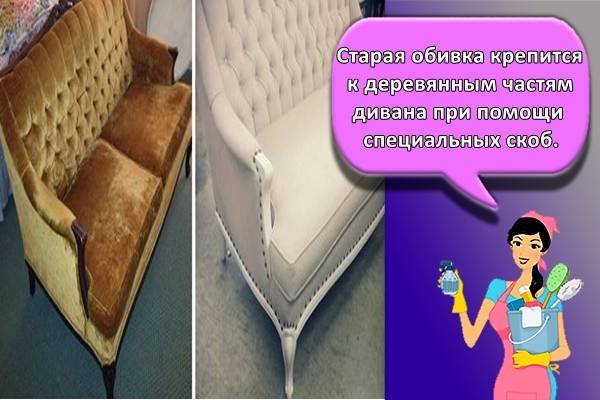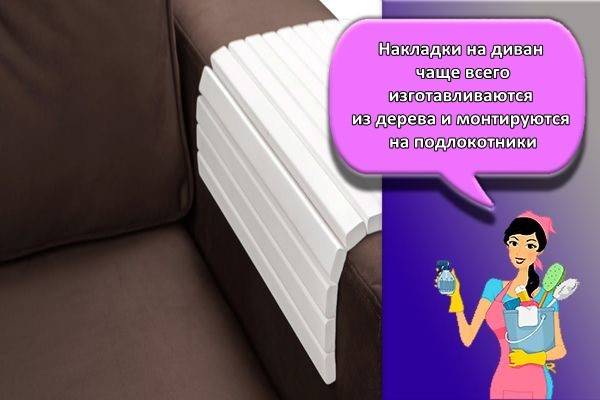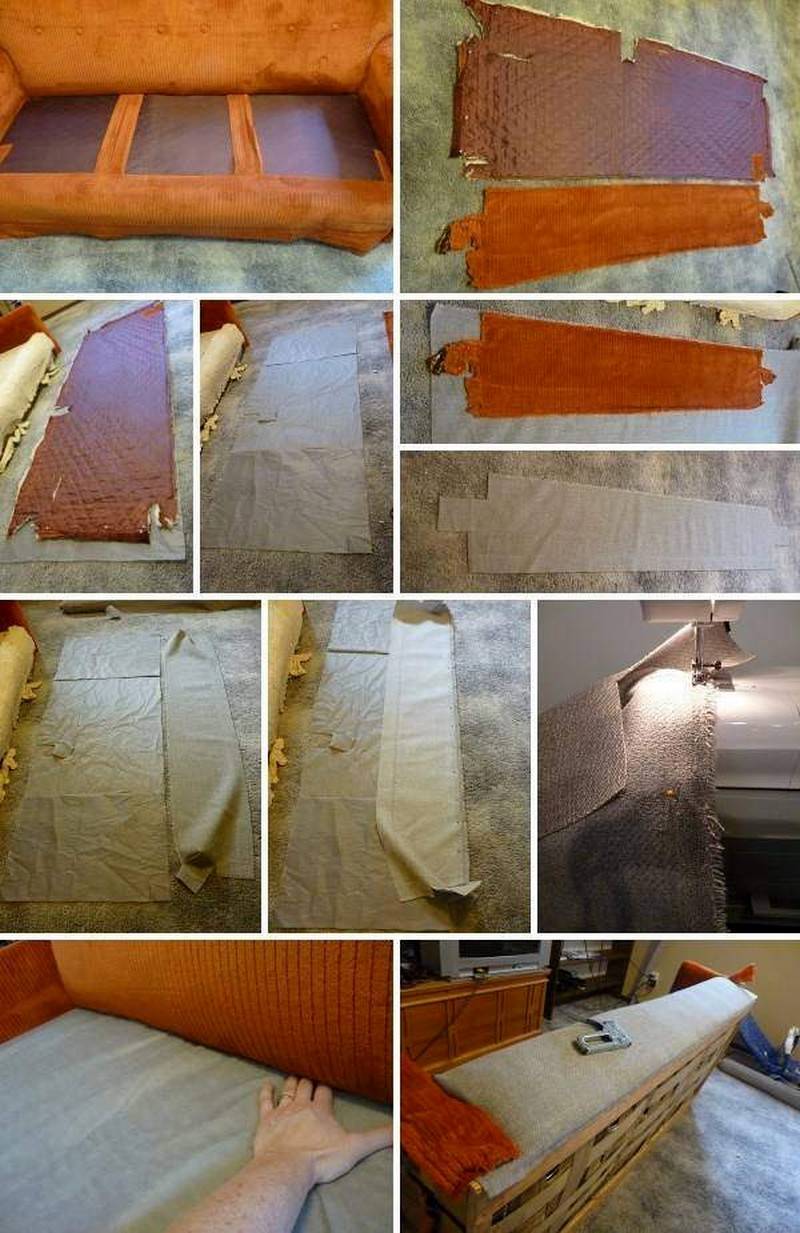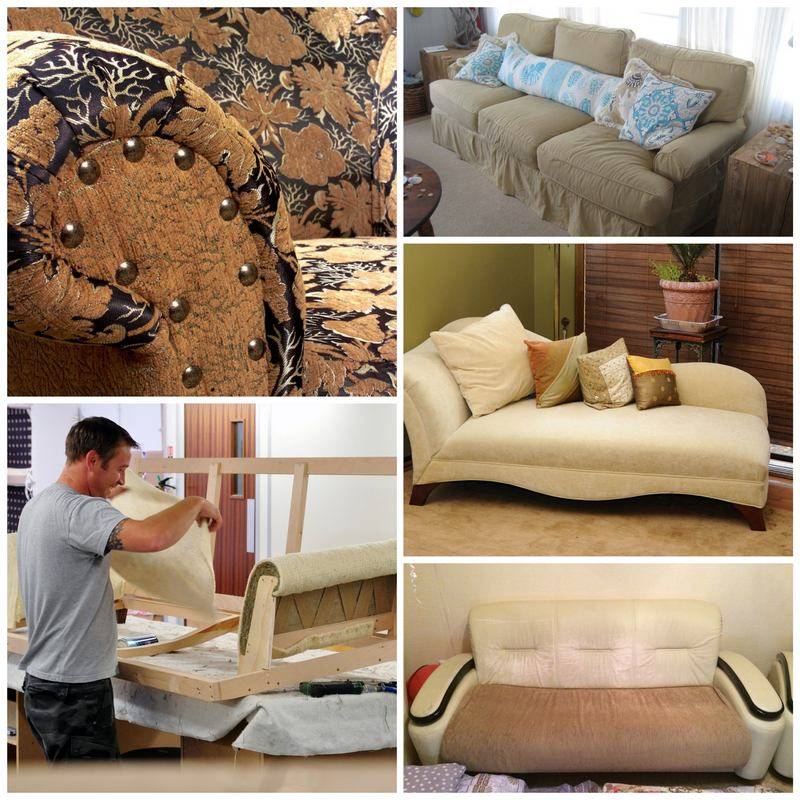Instructions
After all the materials for the restoration have been purchased and the tools have been prepared, it is time to proceed to the repair itself. This process is not complicated, it is enough to be careful and consistently follow all the steps described in the instructions.

Checking and repairing the frame of upholstered furniture
The first step in the restoration of a sofa is to check all of its component parts for integrity and functionality. If any of the boards are rotten or cracked, try to replace them.
Dismantling and checking
After checking the frame, the process of dismantling individual structural elements, such as:
- armrests;
- the back of the sofa;
- upholstery;
- filler;
- springs.
Side armrests
In most models, the fasteners are on the inside, and to get to it, you will need:
- hexagon spanner;
- pliers.
If these tools are available, there will be no difficulties with dismantling.
Seats and backs
The seats and backs are fixed with special fasteners to the lower frame of the sofa. The tools that you prepared before starting the repair of the product will help to cope with the fasteners.
Old upholstery, staples
The old upholstery is attached to the wooden parts of the sofa using special brackets. They must be carefully removed, after which it will not be difficult to remove the upholstery.

Old filler
Once the upholstery has been removed, the sofa filler is accessible. It is advisable to immediately replace it with a new one, but if it is in an acceptable condition, you can leave the old filling as well.
Springs, checking their condition
Once the filler is removed, move on to evaluating the springs. If the result of the inspection showed a satisfactory condition, it is enough to clean and coat the old parts with grease.
Checking the state of the chipboard
Often, it is the chipboard sheets that fall into disrepair in the first place. Replace damaged parts of the structure or leave old ones if their condition allows reuse.
Repair and replacement of old elements
After all the components of the sofa have been dismantled, you can proceed to repair and replace old parts. Subject to inspection:
- base for the spring block;
- spring block;
- mechanisms responsible for disassembling the sofa;
- slats.
Spring block base
The base for the spring block is changed completely if any defects or malfunctions are found. Attachment to the block is carried out by means of a stapler. If we could not find the stapler, we take:
- thin carnations;
- steel wire.
We make staples out of them and fasten the springs.

Spring block
To repair the spring block, you must:
- replace unusable springs;
- cover each side of the block with a thick cloth, which is attached to the part with a nylon thread.
Note! The edges of the fabric are folded inward
Cover and wrap
Fastening the cover and covering the frame with upholstery is carried out using construction glue and a stapler. Remember to replace the old filler or replace it with a new one.
Repair of mechanisms
Repair of sofa mechanisms has its own nuances, depending on which principle of operation is used:
- folding;
- roll-out.
In roll-out ones, the roller most often fails, and in folding ones - springs, which eventually lose their shape and burst.
Lamels
Reasons for lamella breakage:
- poor quality of the material;
- high load on a single section.
The damaged strips are bent until they completely exit the fixing grooves, after which a new part is installed in their place.

Repair of mechanisms
If during operation the back or seat does not fold or it happens with great effort, they are skewed relative to each other, then repair of the transformation mechanism of the sofa-book is required.
What are the dimensions of the problem, it will be possible to detect only after disassembling the product. To do this, you first need to remove the armrests (most often they are attached with two bolts), in order to dismantle the moving parts, you need to unscrew the fasteners in the mechanism itself.
The system is now fully visible, but still attached to the frame of the sofa.If all the components are intact, there is no backlash or other signs of loosening, you can simply lubricate it, lift the mounting bolt. Even the presence of rust does not mean complete failure. You can get rid of it with the help of special chemicals.
In the event of a breakage of the rivets that connect the moving elements of the sofa-book mechanism, they can be easily replaced with others. Before that, you should remove the mechanism, clean it, get rid of the broken parts and put in a replacement.
In extreme cases, especially when the sofa-book has been used for many years, the entire mechanism will have to be replaced. The design is easy to purchase at any furniture store at an affordable price.
A feature of the Eurobook sofa is the presence of a double transformation mechanism, one part of which allows you to push the seat forward, the second lowers the back into the resulting space. Repair or replacement produced in a similar way to the case considered, with one difference: the retractable mechanism is equipped with bearings, which break most often. They will then need to be replaced.
The click-gag model has a metal frame base, to which all movable elements and lamellas are attached. If there are problems with unfolding or 1 rail has broken, you will first have to remove the upholstery, carry out a detailed inspection followed by repair work (replacing fasteners, broken slats, lubricating moving elements).
Restoration process step by step instructions
Do-it-yourself sofa restoration is a laborious and difficult process. In order to avoid mistakes, it is necessary to determine the specifics of damage, to assess the scale of work.
Perhaps the restoration will include the repair of the internal structure, replacement of filler and gasket in the main parts, full or partial re-tightening of furniture.
Required materials and tools
In order to restore the sofa with your own hands, you will need the following tools:
- pliers;
- screwdriver;
- spanner key;
- furniture glue;
- electric drill, screwdriver, drills of different diameters;
- electric jigsaw and saw;
- bolts, nuts, fasteners and metal corners, furniture nails;
- gypsy needle, nylon thread, scissors;
- furniture stapler and staple remover for removing old staples.
The set of tools can be supplemented depending on the complexity and specifics of furniture repair.
Of the materials required:
- upholstery;
- foam rubber or other type of filler;
- tapes for masking seams;
- various decorative elements.
When repairing an ottoman with cushions or bolsters, it is necessary to take into account that the density of the filling of decorative elements differs from the material intended for the seat. All these nuances must be foreseen in advance, so that later there will be no problems.
Filler selection
The filler is selected depending on the sofa model. On the seat and backrest, they acquire a denser and thicker foam rubber. For the side parts and armrests, a thinner material is used.
The choice of upholstery material
To restore the sofa, you can use any fabric, including those that differ in texture from the previous upholstery. For example, instead of a tapestry, you can take suede or velor for upholstery of a soft sofa, such a coating will create coziness and give the product an exquisite look.
Because of practicality, many people prefer to combine fabrics. Some parts of the backrest and armrests can be covered with leather or its substitute, and velor or jacquard are perfect for the backrest along with the seat.
When choosing a fabric for the restoration of old furniture, it is necessary to take into account the general interior, its style and the purpose of the soft modules.
In living quarters, soft and natural fabrics are used. For an office or other places with increased use of furniture, it is better to choose synthetic, wear-resistant, easy-to-clean and dense fabrics.
Dismantling the sofa and its elements
The sofa is disassembled in the following sequence:
- Neatly remove the side parts.Then unscrew the back and disassemble the seat.
- Remove the covering fabric and foam rubber.
- Inspection is carried out. If required, repairs are made to the internal mechanism of the furniture. At this stage, the spring block, wooden frame or belts are replaced. All fasteners are checked. If necessary, they are twisted and glued.
Padding
Old upholstery fabric should be ironed out and used to create patterns. All upholstery details are cut out of the canvas. In this case, it is recommended to observe accuracy and consistency in work.
Each element should be numbered and indicated to which part it belongs. All parts must be swept away for a test fitting. After the adjustment, the fabric is sewn on a sewing machine. Do-it-yourself sofa restoration requires not only knowledge of carpentry, but also tailoring.
In the future, the covers are put on each piece of furniture and attached to the frame from each edge. After that, proceed to the general assembly of the sofa.
The final stage of decoration
The restoration of an old sofa is not only hard physical labor, but also creative work. Decorating is the final and most important part of the process. The updated upholstery itself can become a bright accent, but decorative contrasting pillows and bolsters will add more originality to the sofa. They can be decorated with ribbons, plaits, carriage ties.
If the arms and legs of the ottoman were restored, then they are varnished or painted in the same tone.
The main methods of restoration with your own hands
The restoration process of a leather sofa depends on the condition of the upholstery, the presence of certain defects and the requirements for the final result. When planning to restore and repair furniture, you need to take into account the nuances and select the appropriate materials.
How to remove scratches
Scratching leather upholstery is a common problem. Defects arise from the claws of pets and the effects of various objects. You can use the tools at hand to remove scratches.
Olive oil
If the surface of the sofa is scratched by a dog or cat, you need to apply olive oil to a cotton pad and wipe the scratches. A minor defect will disappear after the skin dries as a result of primary processing. Otherwise, you need to repeat the procedure 2-3 times.
Wax application

Beeswax helps to effectively remove small and shallow scratches on leather furniture. The beekeeping product is heated until soft and the damaged areas are treated. When the wax hardens, gently peel it off the upholstery.
Liquid skin
The use of liquid leather allows you to repair significant damage. The material is applied to scratches and left for several hours until it hardens completely. When the liquid skin hardens, the furniture can continue to be used freely.
Nail polish and marker
From the available tools for removing scratches on the sofa, nail polish and a marker are suitable. A small amount of clear varnish is applied to scratches and allowed to dry. After restoration, a slightly visible transparent crust will remain on the upholstery surface.
Rubber based adhesive
The glue is rubbed into scratches and left to dry. When the damaged areas are covered with a glue crust, you need to additionally treat them with a special paint, selected taking into account the color of the leather sofa.
Shoe cream

Rub the matching shoe polish into the scratched areas. The cream does not eliminate defects, but only visually masks them.
Iron
You can handle the upholstery of a leather sofa with a warm iron. A cotton cloth is applied to the surface of the furniture and ironed over the damaged areas. The duration of each contact between the iron and furniture should not exceed 10 seconds.
Paint or varnish
Specially developed materials for the restoration of leather sofas are used to eliminate abrasions and restore the original color. It is enough to choose a paint or varnish that matches the color and apply it to the upholstery. After drying, you can use the furniture.
Padding
The constriction process consists in a complete change of the sofa upholstery. As a result of the constriction, it is possible to completely change the appearance of the furniture. You can do the work yourself or contact a specialized workshop
For self-constriction, it is important to choose a material of a suitable color and in sufficient quantity
Replacement of fittings
In leather sofas, parts are used to connect individual parts, legs, a transformation mechanism and other accessories.
Patches
Sofa patches are pieces of leather that are fixed on worn-out pieces of furniture. When restoring a sofa without outside help, it is recommended to use self-adhesive patches, on the back of which there is a special Velcro.

Overlays
Sofa covers are most often made of wood and mounted on armrests. The use of overlays allows you to visually hide holes and scuffs. In this case, it is not necessary to repair every damaged area, since the overlay covers a large area at once. In addition, the added benefit is to create a place where you can conveniently store various things.
Pasting
To seal imperfections on the leather upholstery of the sofa, you can use specialized products, including liquid leather and glue-based formulations. The selected product is applied to areas that require restoration, or the upholstery is completely processed. The second option is preferable, since it avoids shade drops.
Repair of the frame and armrests of the sofa
The frame can only be repaired after removing the upholstery and filler, i.e. almost completely disassemble it. It is much easier if the seat and backrest are attached to the frame by a transformation mechanism. They can be simply removed by unscrewing a few screws and screws without touching the soft upholstery.
After accessing the damage, the defects must be carefully examined and decided whether it is possible to restore the old part or is it better to replace it. To do this, self-tapping screws or bolts are unscrewed, the frame elements are measured, their exact copy is created and installed in place.
If another do-it-yourself sofa repair is being carried out, it is recommended to strengthen the supporting structures in each individual case (put a wooden beam, add a couple of transverse boards, install metal corners). In addition, you can tighten the loose fittings of the sofa, treat the joints with glue to prevent their backlash in the future.
Sometimes it is necessary to restore the armrests from which some of the wood has broken off. To do this, collect all the fragments (if there are several of them), determine the location of each and use PVA glue to glue them in place. Then it remains only to lightly sand the gluing place and cover it with a layer of varnish matched to the color.
If you need to repair the armrests with soft upholstery, the fabric and foam rubber are first removed, the broken part is detached. The purchased one is installed in its place. The filler and fabric are returned to their place, and the armrest is screwed onto the frame.
Repair of the transformation mechanism
Possible options for transforming sofas
A high-quality mechanism most often determines the cost of a sofa, since moving parts break faster. There are several types associated with the principle of operation. Each of them requires its own maintenance and problem fixing.
Repair of the roll-out mechanism of the sofa
Diagram of the transformation mechanism of the "Roll-out" sofa
The most common mechanism. The popularity is associated with the simplicity and low cost of execution. It was named so because of the principle of rolling out the section for the "bed" position.It also consists of rollers on an additional section, a slide with a fixing bracket on the body. There is also a lifting mechanism or an additional leg. Frequent problems are braking and squeaking when rolling out. It is solved by replacing the rollers and sleds. There is also a lack of complete fixation in the “bed” position. In this case, repair of the retaining bracket is required.
Repair of the sofa-book mechanism
The scheme of the transformation mechanism of the sofa "Book"
It has been known since Soviet times and is already obsolete. In this regard, it is difficult to find accessories for the device. The sofa uses the front of the backrest as an additional section. The transformation takes place by folding the back and sitting together, removing the roller from the end position, rolling the roller and decomposing the sections. The most common problem is the inability to unfold or fold the sofa. In this case, do not use force. It is “treated” by disassembling the sofa, cleaning the guides, removing the tension from the fixing spring, lubricating the axle and fixing the jam or replacing the roller. In the event of several problems with the mechanism, a complete replacement of the block is preferable.
The new variations use a rocker piece with springs. It is more reliable. But in the event of a malfunction, a complete change is required.
Repair of the mechanism of the sofa "click-clack"
The scheme of the transformation mechanism of the sofa "Click-Klyak"
The most modern type for serial models of upholstered furniture. Has three positions. "Click Klyak" allows, in addition to the seat, to use the backrest and armrests as a sleeping surface. An interesting name is associated with the sound of transformation. Outwardly it looks like a book mechanism. However, it uses a special folding mechanism without rollers. Since the perfect fit of all moving parts of the device cannot be made at home, it is better to change the entire unit. To do this, it is necessary to disassemble the casing and filling and fix the breakage.
Repair of the mechanism of the sofa "accordion"
Diagram of the transformation mechanism of the sofa "Accordion"
Has three positions. Unfolding and fixing occurs due to movable axles and locks. For disassembly you only need a 10 spanner. The locks themselves resemble clamps without a tightening bolt. Frequent problems are similar to those of a sofa-book. All elements must be lubricated periodically.
Repair of upholstered spring furniture: the best way
This method of repairing a spring sofa or chair is considered the most reliable of all existing ones, although it is time-consuming. Let's consider its implementation step by step:
- Make sure you remove any remaining upholstery, staples, and nails from the frame. In this case, the furniture body was already completely ready for the installation of the seat (cleaned, sanded, washed, painted). The springs were removed and set aside for later use. Before that, the master took several photos so as not to forget how they were located.
- Install straps (slings) on the lower part of the seat to secure the springs. The more of these strips you install, the stronger the seat will be. Use a stapler to secure them, leaving a couple of centimeters of cloth on each edge. The tension should be moderate so that the sling sags slightly when pressing on it.
- The extra centimeters on each edge should be folded up and also attached to the frame with a stapler. Repeat these steps until you have installed all the vertical lines, then work the horizontal lines. Remember to intertwine with the vertical ones, not just go under them.
- Reinforce the strength of each strap with three small upholstery studs. This is how the whole process of repairing upholstered furniture looks like in the photo:

5. Now you can go directly to the installation of the springs. You can use the old photo or just distribute them evenly on the support from the lines. The end of each spring should "point" in the same direction as all the others.
6.The springs are attached to the straps either with a special tool or with a thick string of twine and a special button. Each spring must be secured at three points.
7. Drive 2 nails into the end of each vertical and horizontal row of springs.

8. Measure the length of the twine, which will be 2 times the length of the seat plus 40-50 cm. Fold the section in half and create a loop around the nails, as shown in the photo below. After that, pulling the twine, hammer in the nails with a loop with a hammer to the very end.
9. Now our goal is to weave the springs together to form the seat and connect all the springs into a single whole. Start and finish tying knots from each edge on the second "ring" from the top, and then immediately go to the top rings. This will create a domed seat.
10. After tying all the springs together, wrap the twine around the stud and hammer in until it stops. Secure the free end of the thread with a stapler.
11. For the second thread from each fixed loop, repeat steps 9 and 10, but only it should be tied exclusively on the upper rings, without "falling" to the second level from above.
12. Tie all vertical rows in this way, then horizontal rows, and to be sure, you can still walk diagonally. As a result, none of your springs can move apart from the rest. Follow the step-by-step photo for attaching the springs to the upholstered furniture seat:

Finally, there is still the hauling of the finished seat. In this case, the master simply sewed on the fabric (which could also be done with a stapler), and masked the seams with tape.

How to remodel furniture at home?
Just follow the instructions:
Stage I: we begin to restore furniture by disassembling it, which involves unscrewing and removing locks, as well as unfastening old brackets that were needed to fix the upholstery on the frame. Be sure to keep trash bags handy to remove dust and old filler immediately.

Stage II: carrying out repair work and replacing parts that have become unusable. In fact, the restoration of an old but beloved sofa is possible if you choose the right parts. If you notice that cracks have appeared on the beams that form the frame, this indicates that their useful life has come to an end. Replace with solid beams. If you wish, you can order them to the joiner or prepare them yourself. In order for the alteration to be performed efficiently, the joints of the beams should be registered using PVA glue. If you notice broken parts, then they also need to be repaired or new ones installed by sawing them out with a jigsaw.

For their subsequent fixation, the master uses nails or a pneumatic stapler. You will need this tool if you decide to return the furniture to its original appearance. Springs often burst during operation. We repair them by completely replacing the blocks. Sometimes this is the only solution that is suitable in order to normalize the seating of your favorite folding beds.
Stage III: replacement of the filler, which is often foam rubber. Over time, it cakes and becomes unsuitable for further use. We will restore the seat by removing the old material and covering the new one. How to restore the seat? Only in this way, although it can be made easier by leaving the old filler, if it is in a normal state.

Stage IV: replacement of locks is a mandatory stage when restoring furniture.
At the final stage, a new cover is sewn and fixed on the piece of furniture. The same scheme is used to repair Britannic sofas, as well as armchairs.
If such work seems burdensome to you, a master who repairs leather sofas at home will help. He knows exactly how to restore furniture.
How to repair a lifting mechanism with your own hands
Sometimes, together with the slats, the lifting mechanism of the bed breaks down, which is responsible for the transformation of the structure. The following signs indicate a breakdown:
- spontaneous lowering of the orthopedic base;
- jamming of the mechanism when lifting or lowering the structure;
- creaks and other extraneous sounds that occur during operation.
If one of the listed symptoms appears, it is necessary to disassemble the lifting mechanism. To do this, the mattress is removed from the bed, after which its base is unscrewed. Then the fasteners are unscrewed, with the help of which the mechanism is screwed to the structure. It is difficult to repair such a product on your own and therefore it is better to refer it to a master who professionally repairs furniture.









































